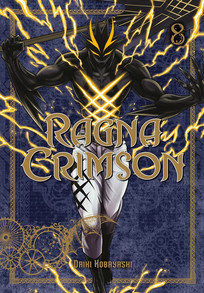Review
by Grant Jones,Ragna Crimson
Volume 8
| Synopsis: |  |
||
The fortress battle reaches its dramatic conclusion. Olto Zora tries to convince the Silverware Princess to join the dragons, the Argentum Corps fight with every ounce of strength they have left, and Ragna faces off with Taratectra. Even as the ritual reaches fruition, surprises and twists are in store. Ragna Crimson is written and drawn by Daiki Kobayashi with editing by Leyla Aker, translation by Stephen Paul, and lettering by Eric Erbes. |
|||
| Review: | |||
Ragna Crimson volume 8 brings to a close the longest battle in the series thus far, and in basically every regard, lives up to the hype. The opening segment with the temptation of the Silverware Princess is interesting. Olto Zora's offer is not particularly compelling; it has to be said. At no point has Starlia expressed anything but contempt for dragons, and she has dedicated her entire life to destroying them directly or creating weapons that will destroy them. We have not gotten any flashbacks showing anything other than her overcoming the odds and striving to be greater than any challenge in her path. So even when she is nominally on death's door and facing oblivion, it isn't surprising that she says, “Nah, I'm good.” This scene gives her a chance to make this statement, though, which is important. Starlia has not had a lot of chances to face dragons directly and have a battle of wills, which creates an opportunity for her to shout her defiance to the heavens. It's an important scene that helps underscore why the Argentum Corps loves her so dearly and why they are willing to die for her in this mission. The Taratectra battle is one for the history books, for sure. Ragna Crimson has been a manga defined by over-the-top battles between super-powered beings, and this fight is one of the best in the run. All of the dragon fights have been exciting thus far, full of high-powered warriors and abilities with incredible scope. Taratectra brings another element to the table, though: scale. Given how powerful Ragna's dragon opponents have been until now, Kobayashi might have a tough time making Taratectra's size feel meaningful in the battle. But he does give off a sense of unbelievable might and grandiosity, largely through how he is framed. The panels are all at wild angles or struggle to contain his bulk inside the frame, making his battle with Ragna seem truly grand. It gives off a sort of “Superman versus Godzilla” vibe that is deeply satisfying. Regarding the emotional heft, I think Kobayashi does a great job of making this loss matter. I'm not saying that Taratectra ends up being a sympathetic character, nor does he pull at the heartstrings - he's a big villain who is a big evil. But drawing on his long-standing connection with Olto Zora does an excellent job adding a tinge of loss to what's happening. If nothing else, the audience can lament that a true bond was broken and that there is some measure of sorrow in that. The fight with Kamui is the other big highlight of the volume. As with Taratectra, it's a throwdown between two titans, and it can be a challenge to constantly create that fresh feeling of tension when the bar for the power level has already been set so high. Two framing devices are crucial to making this so successful. The first is having Kamui be a sort of usurper, a human who claimed dragon power through viciousness. I like this as it not only sets him apart from the rest of the dragons but also makes him comparable to Ragna in many ways. Both of them have achieved their positions through relentless force of will, yet they've done so along different vectors and on different sides. It's a good way to set them up as opposites without doing a basic “I am you… but evil” mirror match. The second is the nine-second countdown. Adding a time element is one of the most basic forms of tension to, well, any activity. Nine seconds is an absurdly small window of time so that so much plays out within that timeframe is awesome in the classic sense of the word. The best bit is displaying the clock during all the back and forth. The art is stellar, and the concept is exciting, but having two superpowered demigods blasting away at each other while the elapsed time is displayed down to the millisecond? That's what really puts it over, and it's an amazing climax to the volume. Of course, there are also several big twists here at the end. Without spoiling it, I was not surprised by what happened, but also I was not prepared for it. I hope this adds to Ragna's need for vengeance and remains a recurring theme for him in future chapters. I honestly don't have any complaints to speak of. At this point, the series is in full swing, delivering on its core premise with aplomb. Kudos to Daiki Kobayashi; this is something great. |
| Grade: | |||
|
Overall : A
Story : A-
Art : A+
+ Excellent action, gorgeous art, terrific framing |
|||
| Production Info: | ||
|
Full encyclopedia details about |
||